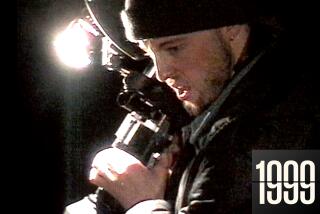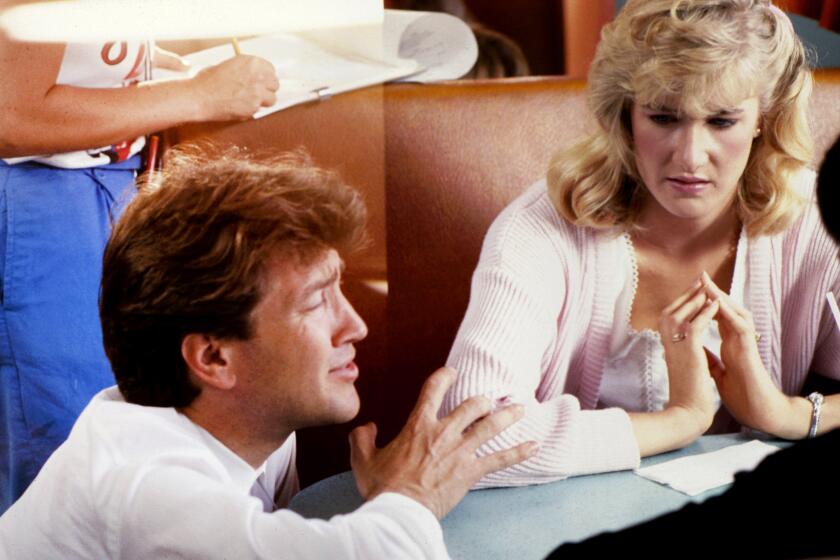The ‘Thin Red’ Battleground
- Share via
Twentieth Century Fox knows it has a battle on its hands with the release next week of “The Thin Red Line,” Terrence Malick’s difficult and unconventional World War II epic.
The film, Malick’s first in 20 years, arrives Dec. 23 with the same level of anticipation, curiosity and mixed reactions that greeted another singular take on war--no, not Steven Spielberg’s “Saving Private Ryan” but Francis Ford Coppola’s “Apocalypse Now” in 1979.
Fox plans a marketing strategy for “Thin Red Line” that was used successfully for “Apocalypse”--opening the film in only one theater in New York and L.A., then waiting almost a month before opening it wider, targeting upscale urban, film-buff audiences to help build word-of-mouth.
Early screenings of Malick’s still-incomplete print of “Thin Red Line,” which stars Sean Penn, Nick Nolte among an ensemble cast, have generated widely disparate reactions from critics and the media, and Hollywood is buzzing about how the film will play. One thing is clear: The iconoclastic Malick’s film is likely to sharply divide audiences and leave Fox with a marketing challenge.
Viewers who liked or disliked the film did so for myriad reasons, according to Laura Ziskin, head of Fox 2000’s production division, which financed Malick’s intimate war epic.
Mike Medavoy, whose Phoenix Pictures produced “Thin Red Line,” says he’s not surprised at the varied response.
“Some people came in looking for a conventional war movie. This is not a conventional film. And Malick is not a conventional filmmaker,” Medavoy says.
After early screenings last week, Malick cut almost five minutes from the body of the nearly three-hour film and attached an eight-minute credit sequence at the end. The sound has been fine-tuned with some redubbing in the wake of complaints at one of the Los Angeles screenings that some of the voices weren’t audible.
Ziskin admits that even though she had seen the film several times, at a Century City press screening she had trouble understanding some of the characters’ voice-over monologues. Reviewers have been invited back to see the completed film.
In Los Angeles, moviegoers will have to travel to Westwood to see “Thin Red Line’s” Dec. 23 debut. “We’re opening in the best single-standing theater in each major city--theaters that mean something--the Village in Los Angeles, the Ziegfeld in New York,” says Fox Film Group Chairman Tom Sherak.
Then on Jan. 8 the film opens in similar venues in other cities as well as a few other theaters in Southern California. The film doesn’t go into wider release until Jan. 15.
“Apocalypse” actually sold reserved seats when it was first released. But release patterns have changed radically since then, and reserved-seat engagements are no longer practical. Due to ever-increasing production and marketing costs, studios are releasing films much more quickly to recoup more money in a shorter period of time.
Fox is hoping that by Jan. 15 sufficient interest in the film will have been generated to lure the suburban multiplex audience. The response to the film at that time will ultimately decide how wide the film will go. At this stage the plan is to go out in only 1,000 to 1,200 theaters, says Sherak, again in mostly upscale metropolitan areas.
Malick’s World War II film is being released about six months after the debut of Spielberg’s widely praised and wildly popular war saga, “Saving Private Ryan.” That’s similar to the experience of releasing “Apocalypse,” which arrived on the heels of another Vietnam epic, the Oscar-winning “The Deer Hunter.”
“Deer Hunter” stole much of “Apocalypse’s” Oscar thunder. And that may happen this year too. “Ryan” already has copped the Los Angeles Film Critics award for best picture and is considered the film to beat for the Academy Awards.
“Ryan” takes place on the European front whereas ‘Thin Red Line’ is set in the Pacific’s Guadalcanal. But setting is just one of many ways in which the films take separate courses, say those involved in “Thin Red Line.” (Malick, as usual, is not speaking to the press.)
“Ours is a much more personal, idiosyncratic film,” says Ziskin. “The film has more in common with Malick’s earlier films,” among them “Badlands” (1973) and “Days of Heaven” (1978).
Marketing Will Stress the Artistic Process
In tone, “Ryan” is harshly realistic and ultimately patriotic. “Spielberg’s movie starts in hell and ends with redemption. Malick’s film starts in paradise and then takes you to hell and back,” observes Medavoy.
As in his previous films, Malick’s narrative is less structured and more impressionistic. Notes Medavoy: “The film may take place during World War II, but it’s more about the nature of war and humanity.”
Fox will invoke strategies used by “Apocalypse” in the marketing and distribution campaign for the $52-million “‘Thin Red Line.”’ The marketing stresses the importance of the movie’s themes and the artistic nature of the filmmaking.
In spite of its mainstream production budget, says a marketing source at Fox, “Thin Red Line” shares many of the virtues of smaller, specialized films like “The Full Monty,” “The English Patient” and “Life Is Beautiful,” which need to be nurtured and ultimately achieve their potential through word-of-mouth. Trailers and TV ads for “Thin Red Line” will emphasize its singular nature.
“One of the things we’re trying to do is appropriately convey the scope and humanity of the movie,” says one Fox marketing executive. “It is a movie that takes place during World War II in a battlefield. But it’s not just a war movie. And the images we’ll present are all open to interpretation.”
Even the print ads for the film play down the war genre without ignoring it entirely. “When you first look at the ad, you’re not sure what it is,” says the Fox marketer. “You have to look at it closely to see the three soldiers’ heads.”
Review ads will try to capitalize on Malick’s importance as a filmmaker. The studio even hopes to use the expected lack of unanimity among critics to its advantage, fanning the flames of controversy and debate. The gambit worked for “Apocalypse.” Despite extremely divergent reviews and audience reaction, Coppola’s film was a box-office hit.
Will it work again for “Thin Red Line”? “It’s a gamble,” admits Sherak. “But then that’s what the movie business is all about.”
More to Read
Only good movies
Get the Indie Focus newsletter, Mark Olsen's weekly guide to the world of cinema.
You may occasionally receive promotional content from the Los Angeles Times.










